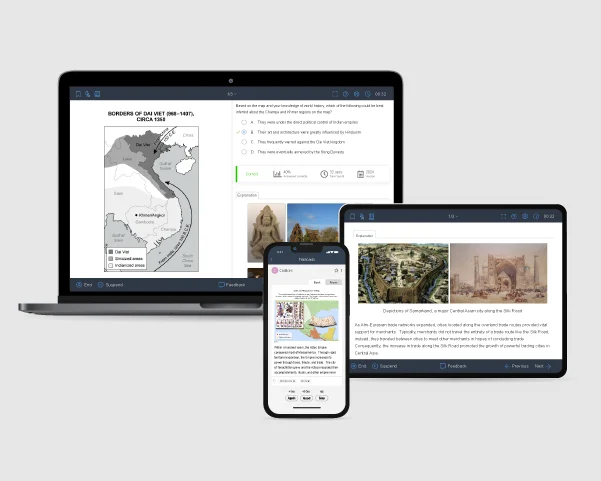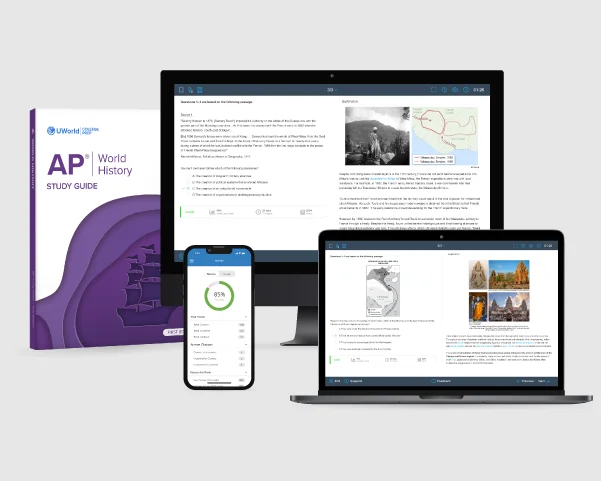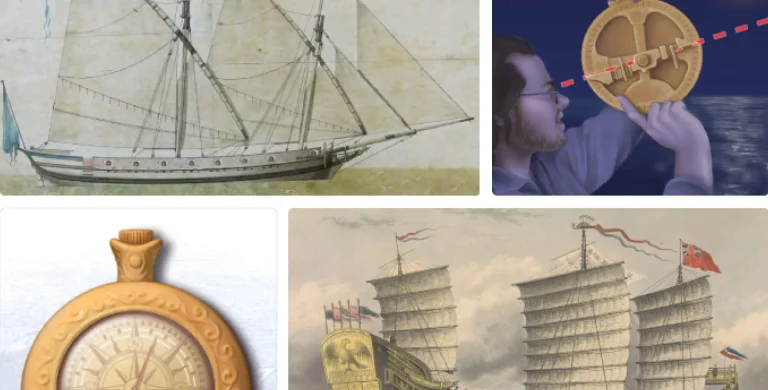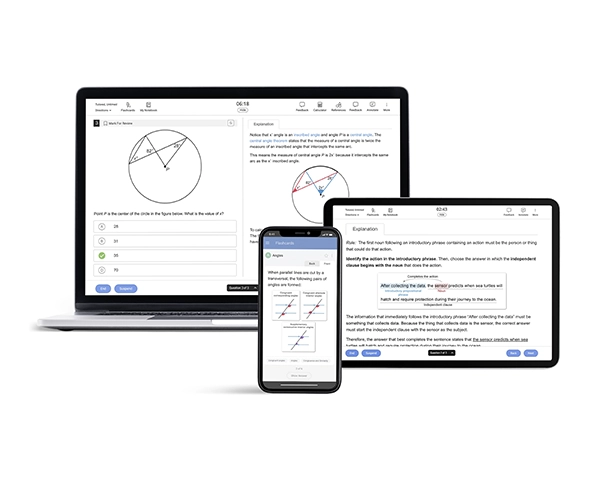What Is the Exam Format for AP World History?
The AP World History exam typically consists of two main sections with three different question types: (I) multiple-choice questions and short-answer questions, and (II) essay questions. The AP World History exam is challenging and is 3 hours and 15 minutes long.
Here's an overview of the AP World History exam format:
Section I includes multiple-choice (MCQ) and short-answer questions. The 55 multiple-choice questions must be answered in 55 minutes. You have 40 minutes to answer three 2-to-3-part short-answer questions (SAQ). Spend one minute on each MCQ and 10 to 12 minutes on each short answer question. This gives you time to review your answers and find any you missed.
Section II is free-response questions, which includes one document-based question (DBQ) and one long essay question (LEQ). You have 60 minutes to complete the DQB, which includes a 15-minute reading period. The recommended time for answering long essay questions is 40 minutes.
You can read our article on the AP World History Course and Exam Description to understand the format and each unit's weightage better.

Types of Questions in the AP World History Exam
As we mentioned earlier, the AP World History exam format has four main types of questions. These questions will test your historical thinking skills and your knowledge of the six “themes” of the course themes. But just having knowledge won't guarantee a high score. It's crucial to know how to answer these questions. We will go over the AP World History exam structure and each question type to help you prepare better.
| Sections | Parts | Question Types | Time Allocated | Exam Weight |
|---|---|---|---|---|
| I | Part A: Multiple-choice Questions | 55 MCQs | 55 minutes | 40% |
| Part B: Short-Answer Questions | 3 SAQs | 40 minutes | 20% | |
| Question 1: Secondary source(s) | ||||
| Question 2: Primary source | ||||
| Students should select one: Question 3: No stimulus Question 4: No stimulus |
||||
| II | Free-response questions | 2 FRQs | ||
| Question 1: Document-based Question | 60 minutes | 25% | ||
| Question 2: Long Essay | 40 minutes | 15% |
These are the AP World History topics that may be covered in each of the 9 units, their chronological periods and weightage.
| Units Tested | Chronological Period | Weighting |
|---|---|---|
| Unit 1: The Global Tapestry | c. 1200 to c. 1450 | 8%–10% |
| Unit 2: Network of Exchange | 8%–10% | |
| Unit 3: Land-Based Empires | c. 1450 to c. 1750 | 12%–15% |
| Unit 4: Transoceanic Interconnections | 12%–15% | |
| Unit 5: Revolutions | c. 1750 to c. 1900 | 12%–15% |
| Unit 6: Consequences of Industrialization | 12%–15% | |
| Unit 7: Global Conflict | c. 1900 to the present | 8%–10% |
| Unit 8: Cold War and Decolonization | 8%–10% | |
| Unit 9: Globalization | 8%–10% |
Streamline your studies with our AP World History Prep Course, which breaks down the format, units, and key concepts into easy-to-digest lessons.
- Section I
- Section II
Part A: Multiple-Choice Questions (MCQ)
Section I, Part A of the AP World History exam consists of 55 multiple-choice questions, accounting for 40% of your score, with a time limit of 55 minutes. The MCQs are in sets of three to four questions, each containing document excerpts, images, graphs, and maps. There will also be at least one set of paired text-based stimuli. This section tests how you analyze the stimuli given, along with the historical processes and events mentioned in them.
Make sure you do not leave any MCQ blank. Guess if you have to, and you might earn 1 point for each potential correct answer!
Part B: Short Answer Questions (SAQ)
Section I, Part B of the AP World History exam consists of 3 short-answer questions, accounting for 20% of your score, with a total time limit of 40 minutes.
- Question 1 (mandatory): Includes a secondary resource stimulus, and covers events and processes from the period c. 1200 to 2001.
- Question 2 (mandatory): Includes a primary resource stimulus, and covers events and processes from the period c. 1200 to 2001.
- Questions 3 or 4: No stimulus provided. You can choose between question number 3 (c.1200 and 1750) or 4 (1750 - 2001).
Per the 2024 WHAP scoring criteria, the SAQs constitute 12 points, so each question equals 3 points.
Section II of the AP World History exam consists of two free-response questions, accounting for 40% of your score, with a total time limit of 1 hour and 40 minutes. This section includes one Document-Based Question (DBQ) and one Long Essay Question (LEQ).
Part A: Document-Based Questions (DBQ)
Part A of Section II will present you with 7 documents offering different perspectives on a specific historical event or process between the period 1450 - 2001. Your task would be to analyze and evaluate them, and respond to the prompt. Your answer must offer a defensible claim or thesis with a coherent line of reasoning, and demonstrate your thorough understanding of the historical period and the events that support your claim . Throughout your thesis, you must demonstrate In addition you’ll be asked to:
- Provide a wider historical context that is relevant to the given prompt.
- Use at least 4 from the given documents to support your argument.
- Provide an additional piece of historical evidence that is not provided in the given documents to support your claim.
- For at least two documents, you’ll have to explain how or why the document supports your thesis.
Each DBQ is worth 7 points.
Part B: The Long Essay Question (LEQ)
When tackling the long essay question, make sure your thesis makes sense historically, give a full picture of the historical background, and back up your points with at least two good pieces of evidence. Use historical reasoning like comparing or explaining cause and effect. Show a deep understanding of history through smart arguments and evidence. You’ll be given three LEQs to choose from, each covering different historical eras.
- LEQ 1: c. 1200-1750
- LEQ 2: c. 1450-1900
- LEQ 3: 1750-2001
Per the 2024 WHAP scoring rubric, the LEQ is worth 6 points, so spend some time carefully drafting your thesis. Cover all essential topics efficiently with our APWH study guide, featuring clear explanations, exam tips, and must-know content for a top score.
Curious to learn more about how each question type is graded? Our WHAP scoring guide explains the detailed rubric of how each SAQ, DBQ and LEQ is graded. Don’t forget to check it out!
Can I take the AP World History exam in digital mode?
Yes! The AP World History exam is entirely digital, with students taking both sections through the Bluebook testing app.
Exam success starts with knowing the AP World History exam structure. You can create an effective study plan now that you know the exam format and what to expect from each section. Do not forget to give yourself enough time to review your answers after each section.
Key Takeaways
We hope this format guide has been helpful. Here are three takeaways for the upcoming AP World History exam.
- AP World History takes 3 hours and 15 minutes. Due to the length of the exam, you should take at least one practice test.
- AP World History has two parts. Part A of Section I has 55 MCQs, and Part B has 3 SAQs. Section II has a DBQ and an essay.
Ready to ace AP World History? Get started with our interactive AP World History QBank and study guide designed by experts to ensure your success.
References
- AP World History: Modern Exam – AP Central | College Board. (n.d.). Retrieved December 27, 2024, from https://apcentral.collegeboard.org/courses/ap-world-history/exam
- AP World history modern course and exam description. (n.d.). Retrieved December 27, 2024, from https://apcentral.collegeboard.org/pdf/ap-world-history-modern-course-and-exam-description.pdf?course=ap-world-history-modern

Read More About the AP World History Exam
Explore our AP World History curriculum guide for detailed information on the exam structure, key concepts, and the units and topics you'll study throughout the course.
AP World History Scoring GuideThis article has everything you need to know about how the AP World History exam is scored, score distribution, and average score needed to earn college credit.
AP World History Modern Study PlanDo you want to learn the most effective strategies and resources for achieving your desired score? Click on UWorld's comprehensive APWH study plan to aim for a 5.
Best AP World History Prep Course ReviewFind the top AP World History prep courses with engaging lessons, practice tests, and expert tips to help you master the exam and secure your college admissions.
AP World History Study Guide ComparisonCompare the top AP World History study guides to find the best resources, including reviews, practice questions, detailed explanations to help you excel on APWH.
How to Self-Study for AP World HistorySelf-study for AP World History like a pro with our guide featuring personalized tips, essential materials, and proven methods to prepare confidently for your APWH exam.



